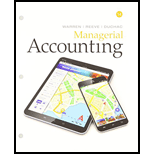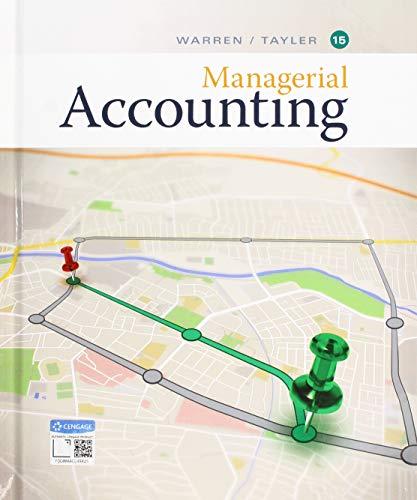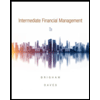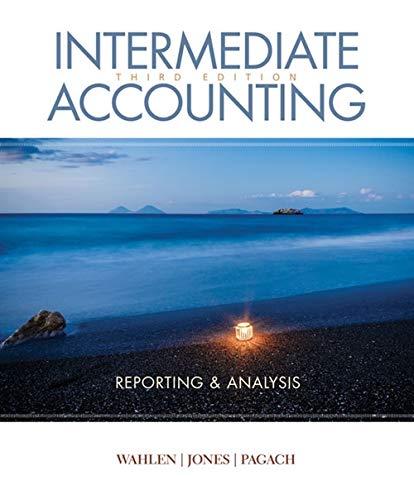
Bundle: Managerial Accounting, Loose-leaf Version, 14th - Book Only
14th Edition
ISBN: 9781337541398
Author: Carl Warren; James M. Reeve; Jonathan Duchac
Publisher: Cengage Learning
expand_more
expand_more
format_list_bulleted
Question
Chapter 14, Problem 1DQ
To determine
Determine the differences between liquidity, solvency, and profitability ratios.
Expert Solution & Answer
Explanation of Solution
Financial Ratios: Financial ratios are the metrics used to evaluate the capabilities,
profitability, and overall performance of a company.
In general, as said above, financial ratios are mainly used for evaluation of the liquidity, capabilities, profitability, and overall performance of a company.
Thus, following are the financial ratios and its measure:
- •
Liquidity ratio : Liquidity ratios are used to measure the ability of the company towards fulfilling the obligations and requirements of the cash at the short-term. Some of the ratios arecurrent ratio , acid-test ratio, inventory turnover ratio, andaccounts receivable ratio. - • Solvency ratio: Next, solvency ratios are those ratios used to measure the ability of the company towards survival for a longer period.
- • Profitability ratio: Profitability ratios are those ratios used to measure the extent of income for particular time period.
Conclusion
Thus, above are the differences between liquidity, solvency, and profitability ratios.
Want to see more full solutions like this?
Subscribe now to access step-by-step solutions to millions of textbook problems written by subject matter experts!
Students have asked these similar questions
On January 1, 2025, Cheyenne Corporation purchased 20% of the common shares of Ayayai Company for $182,000. During the year,
Ayayai earned net income of $90,000 and paid dividends of $22,500.
Prepare the entries for Cheyenne to record the purchase and any additional entries related to this investment in Ayayai Company in
2025. (List all debit entries before credit entries. Credit account titles are automatically indented when amount is entered. Do not indent
manually. If no entry is required, select "No Entry" for the account titles and enter O for the amounts.)
Account Titles and Explanation
Equity Investments
Cash
(To record purchase of stock.)
Cash
Interest Revenue
(To record receipt of dividends.)
Equity Investments
Investment Income
(To record revenue.)
Debit
65,000
2,600
Credit
65,000
2,600
Explain what we mean by consolidation (or consolidated financial statements)?
What is the Equity Method? How and when is this method applied to account for investment securities owned by a company?
Chapter 14 Solutions
Bundle: Managerial Accounting, Loose-leaf Version, 14th - Book Only
Ch. 14 - Prob. 1DQCh. 14 - What is the advantage of using comparative...Ch. 14 - Prob. 3DQCh. 14 - Prob. 4DQCh. 14 - Prob. 5DQCh. 14 - What do the following data, taken from a...Ch. 14 - Prob. 7DQCh. 14 - Prob. 8DQCh. 14 - Prob. 9DQCh. 14 - Prob. 10DQ
Ch. 14 - Prob. 1BECh. 14 - Prob. 2BECh. 14 - Prob. 3BECh. 14 - Prob. 4BECh. 14 - Prob. 5BECh. 14 - Prob. 6BECh. 14 - Prob. 7BECh. 14 - Prob. 8BECh. 14 - Prob. 9BECh. 14 - Prob. 10BECh. 14 - Prob. 11BECh. 14 - Prob. 1ECh. 14 - Prob. 2ECh. 14 - Prob. 3ECh. 14 - Prob. 4ECh. 14 - Prob. 5ECh. 14 - Prob. 6ECh. 14 - Prob. 7ECh. 14 - Current position analysis The bond indenture for...Ch. 14 - Prob. 9ECh. 14 - Accounts receivable analysis Xavier Stores Company...Ch. 14 - Prob. 11ECh. 14 - Prob. 12ECh. 14 - Ratio of liabilities to stockholders equity and...Ch. 14 - Prob. 14ECh. 14 - Prob. 15ECh. 14 - Prob. 16ECh. 14 - Prob. 17ECh. 14 - Prob. 18ECh. 14 - Prob. 19ECh. 14 - Prob. 20ECh. 14 - Prob. 21ECh. 14 - Prob. 22ECh. 14 - Prob. 23ECh. 14 - Prob. 24ECh. 14 - Prob. 25ECh. 14 - Comprehensive income Anson Industries, Inc.,...Ch. 14 - Prob. 1PACh. 14 - Prob. 2PACh. 14 - Prob. 3PACh. 14 - Measures of liquidity, solvency, and profitability...Ch. 14 - Prob. 5PACh. 14 - Prob. 1PBCh. 14 - Prob. 2PBCh. 14 - Prob. 3PBCh. 14 - Prob. 4PBCh. 14 - Prob. 5PBCh. 14 - Prob. 1FSACh. 14 - Prob. 1ADMCh. 14 - Prob. 2ADMCh. 14 - Prob. 3ADMCh. 14 - Prob. 1TIFCh. 14 - Prob. 3TIF
Knowledge Booster
Similar questions
- Indigo Corporation purchased for $277,000 a 30% interest in Murphy, Inc. This investment enables Indigo to exert significant influence over Murphy. During the year, Murphy earned net income of $183,000 and paid dividends of $64,000. Prepare Indigo's journal entries related to this investment. (List all debit entries before credit entries. Credit account titles are automatically indented when amount is entered. Do not indent manually. If no entry is required, select "No Entry" for the account titles and enter O for the amounts.) Account Titles and Explanation (To record the purchase.) (To record the net income.) (To record the dividend.) Debit Creditarrow_forwardIndigo Corporation purchased for $277,000 a 30% interest in Murphy, Inc. This investment enables Indigo to exert significant influence over Murphy. During the year, Murphy earned net income of $183,000 and paid dividends of $64,000. Prepare Indigo's journal entries related to this investment. (List all debit entries before credit entries. Credit account titles are automatically indented when amount is entered. Do not indent manually. If no entry is required, select "No Entry" for the account titles and enter O for the amounts.) Account Titles and Explanation (To record the purchase.) (To record the net income.) (To record the dividend.) Debit Creditarrow_forwardCheyenne Corporation purchased 400 shares of Sherman Inc. common stock for $12,900 (Cheyenne does not have significant influence). During the year, Sherman paid a cash dividend of $3.25 per share. At year-end, Sherman stock was selling for $37.00 per share. Prepare Cheyenne' journal entries to record (a) the purchase of the investment, (b) the dividends received, and (c) the fair value adjustment. (Assume a zero balance in the Fair Value Adjustment account.) (List all debit entries before credit entries. Credit account titles are automatically indented when amount is entered. Do not indent manually. If no entry is required, select "No Entry" for the account titles and enter O for the amounts.) No. Account Titles and Explanation (a) Debt Investments Cash (b) Cash Dividend Revenue (c) Fair Value Adjustment Unrealized Holding Gain or Loss - Income Debit Creditarrow_forward
- Crane Corporation purchased 360 shares of Sherman Inc. common stock for $11,800 (Crane does not have significant influence). During the year, Sherman paid a cash dividend of $3.25 per share. At year-end, Sherman stock was selling for $34.50 per share. Prepare Crane' journal entries to record (a) the purchase of the investment, (b) the dividends received, and (c) the fair value adjustment. (Assume a zero balance in the Fair Value Adjustment account.) (List all debit entries before credit entries. Credit account titles are automatically indented when amount is entered. Do not indent manually. If no entry is required, select "No Entry" for the account titles and enter O for the amounts.) No. Account Titles and Explanation Debit Credit (a) (b) (c)arrow_forwardIndigo Corporation purchased trading investment bonds for $65,000 at par. At December 31, Indigo received annual interest of $2,600, and the fair value of the bonds was $62,200. Prepare Indigo' journal entries for (a) the purchase of the investment, (b) the interest received, and (c) the fair value adjustment. (Assume a zero balance in the Fair Value Adjustment account.) (List all debit entries before credit entries. Credit account titles are automatically indented when amount is entered. Do not indent manually. If no entry is required, select "No Entry" for the account titles and enter O for the amounts.) No. Account Titles and Explanation Debit Credit (a) (b) (c)arrow_forwardSwifty Corporation purchased trading investment bonds for $40,000 at par. At December 31, Swifty received annual interest of $1,600, and the fair value of the bonds was $37,600. Prepare Swifty' journal entries for (a) the purchase of the investment, (b) the interest received, and (c) the fair value adjustment. (Assume a zero balance in the Fair Value Adjustment account.) (List all debit entries before credit entries. Credit account titles are automatically indented when amount is entered. Do not indent manually. If no entry is required, select "No Entry" for the account titles and enter O for the amounts.) No. Account Titles and Explanation Debit Credit (a) (b) (c)arrow_forward
- about investment securities owned by a company, what do we mean by “significant influence”?arrow_forwardwhat is the working capital?arrow_forwardStatement of Financial position as at September 30 for 2023 and 2024 Assets 2023 2024 Cash and equivalents………………………………………. $56,100 $37,694 Receivables, Trade, less allowances of $1,104 and $991 respectively 47,753 37,645 Other Receivables…………………………………………………… 233 516 Inventories…………………………………………………………… 29,587 23,202 Prepaid expenses and other………………………………………….. 4,739 4,143 Total current assets…………………………………………………... 138,412 103,200 Property, plant and equipment, at cost………………………………. 314,880 298,609 Less accumulated depreciation………………………………………. (225,406) (211,494) Property, plant and equipment net…………………………………… 89,474 87,115 Other assets Goodwill……………………………………………………………...…arrow_forward
- Swifty Corporation had 2025 net income of $1,169,000. During 2025, Swifty paid a dividend of $2 per share on 87,850 shares of preferred stock. During 2025, Swifty had outstanding 301,000 shares of common stock. Compute Swifty's 2025 earnings per share. (Round answer to 2 decimal places, e.g. 3.56.) Earnings per share GA $ per sharearrow_forwardGFH Decorators, a partnership, had the income and expenses shown in the spreadsheet below for the current tax year. Identify whether each item is an "Ordinary Business Income" item (reported on Page 1, Form 1065), a "Separately Stated Item" (reported on Schedule K, Form 1065), or both. Enter the value of ordinary income items in column C and the value of separately stated items in column D. Note that not all the cells in either column C or D will have values. If a response is zero, leave the cell blank.Use a minus sign to enter negative values. A B C D 1 Ordinary Business Income Separately Stated Items 2 Fee revenue $600,000 3 Dividend income $2,000 4 Capital gain distributions $10,000 5 Charitable contributions (cash) ($500) 6 Salaries to employees ($150,000) 7 Partner guaranteed payments ($75,000) 8 MACRS depreciation on office furniture ($3,000) 9 Total ordinary business income $0arrow_forwardexplain why preferred stock is referred to as a "hybrid security"?arrow_forward
arrow_back_ios
SEE MORE QUESTIONS
arrow_forward_ios
Recommended textbooks for you
 Managerial AccountingAccountingISBN:9781337912020Author:Carl Warren, Ph.d. Cma William B. TaylerPublisher:South-Western College Pub
Managerial AccountingAccountingISBN:9781337912020Author:Carl Warren, Ph.d. Cma William B. TaylerPublisher:South-Western College Pub EBK CONTEMPORARY FINANCIAL MANAGEMENTFinanceISBN:9781337514835Author:MOYERPublisher:CENGAGE LEARNING - CONSIGNMENT
EBK CONTEMPORARY FINANCIAL MANAGEMENTFinanceISBN:9781337514835Author:MOYERPublisher:CENGAGE LEARNING - CONSIGNMENT Intermediate Financial Management (MindTap Course...FinanceISBN:9781337395083Author:Eugene F. Brigham, Phillip R. DavesPublisher:Cengage Learning
Intermediate Financial Management (MindTap Course...FinanceISBN:9781337395083Author:Eugene F. Brigham, Phillip R. DavesPublisher:Cengage Learning Intermediate Accounting: Reporting And AnalysisAccountingISBN:9781337788281Author:James M. Wahlen, Jefferson P. Jones, Donald PagachPublisher:Cengage Learning
Intermediate Accounting: Reporting And AnalysisAccountingISBN:9781337788281Author:James M. Wahlen, Jefferson P. Jones, Donald PagachPublisher:Cengage Learning

Managerial Accounting
Accounting
ISBN:9781337912020
Author:Carl Warren, Ph.d. Cma William B. Tayler
Publisher:South-Western College Pub

EBK CONTEMPORARY FINANCIAL MANAGEMENT
Finance
ISBN:9781337514835
Author:MOYER
Publisher:CENGAGE LEARNING - CONSIGNMENT

Intermediate Financial Management (MindTap Course...
Finance
ISBN:9781337395083
Author:Eugene F. Brigham, Phillip R. Daves
Publisher:Cengage Learning

Intermediate Accounting: Reporting And Analysis
Accounting
ISBN:9781337788281
Author:James M. Wahlen, Jefferson P. Jones, Donald Pagach
Publisher:Cengage Learning